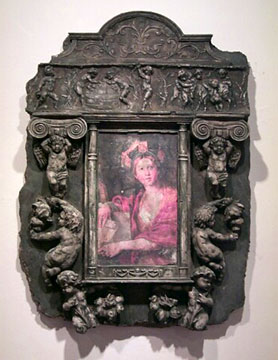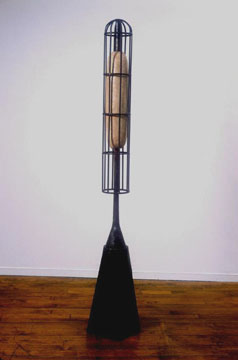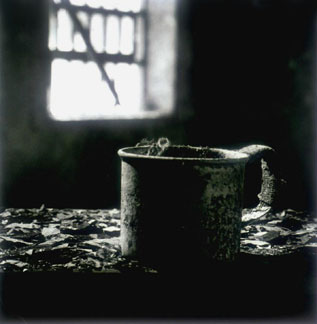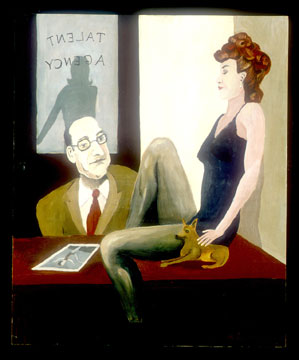
 |
DAVID GIESE
Unrestored Fragment from the Palace of Earthly Delights - 2002
concrete, mixed media
51 x 38 x 7 inches (129.54 x 96.52 x 17.78)
David Giese "History is a combination of reality and lies. The reality of history becomes a lie. The unreality of the fable becomes the truth." -Jean Cocteau The Villa Bitricci never existed. It is a fictitious place. The site and all the artifacts supposedly found there arose from the studio and imagination of artist David Giese. While Giese's on-going project Excavations from the Villa Bitricci is a lie, it is a lie with a distinguished purpose. As Picasso noted about art in general, these fabricated ruins do reveal a certain truth. They provide insight into that perplexing series of styles, monuments and personalities known collectively as "western civilization." Giese's work belongs to that current style known as postmodernism. Arising first in architecture in the 1970's as a response to reductive, formalist trends in modern art and design, postmodernism broadened art's scope of reference by using historical paraphrase, irony, and parody. One key strategy of postmodernism is appropriation, the conscious borrowing of pre-existing images. Giese appropriates the grand tradition of classical art to reflect on its relevance for our time. It is fitting that the Villa Bitricci is named for Dante's great love. Giese's work argues for an art based not just on intellect but on emotions and passion. His imagery is visual, visceral and sensuous. These interiors combine the crude and the refined, the tawdry and the sublime, the sacred and the profane, all for the purpose of giving visual pleasure. To Giese, aesthetic experience is foremost a celebration of the senses. Nostalgia is vital to this project. The villa stands as a paradigm for cultural memory. Part of its allure is based on the fact that it was continually inhabited. In our transient culture, where people move constantly, the idea of a home that endured for centuries is a romantic dream, a comfort-ing image of stability. Giese's choice of an Italian villa was far from arbitrary. The structure reflects two eras-Ancient Rome and the Renaissance-which are remote in time, but are similar in many ways to our own. One may even argue that our contemporary society was founded upon these cultures. Giese uses the forms of classical European art to address a perplexing phenomenon in our own Iate industrial society: the loss of contact with the real. Postmodern theorist Jean Baudrillard has argued that in contemporary culture, media has become so powerful and pervasive that people no longer experience reality directly; we are conditioned to see everything as a manipulated image, as a simulation. Giese's simulated archeology turns the classical past into a grand theatrical display. David Giese is a professor of art and chairman of the Department of Art at the University of Idaho. He received his B.S. and B.A. degrees from Mankato State University in Minnesota and his M.F.A. from the University of Arizona in Tucson. He has taught at the University of Arizona and Alverno College in Wisconsin, and was artist-in-residence at the University of Nevada at Las Vegas. Excerpt from: Michael Zakian, Director of the Frederick R. Weisman Museum of Art.
David Giese
 |
ROBERT
ROHM
Untitled (Caged Core) - 2001-2002
steel, mesh, encaustic
85.5 x 11 x 11 inches (217.17 x 27.94 x 27.94 cm)
Robert Rohm This current body of work is an ongoing attempt to make "quiet" sculptures that are, for the most part, figurative referenced. I'm interested in the "figure" as a relationship of parts, as a vessel or container. Can the figure be "present" through the manipulation of the forms of its shell or covering and can the core of the self be exposed as being present, in the process of departing, or absent. Can that form or combination of forms have a compelling resonance while being familiar and unknown at the same time? The sculptures come from a distillation and synthesis of complex and overlapping feelings about the self and are meant to elicit reflective and contemplative responses in the viewer.
In formal terms I want the sculptures to be straightforward. In some, their underlying structure is exposed. A form which can be both opaque and transparent and which reveals its underlying armature as part of its rhythm is of considerable interest to me. The use of an encaustic surface facilitates this interest and adds the complexity and force of color to the equation.
Robert Rohm, 2002
 |
RICHARD TAYLOR
Big Cheetah - 2001
steel, mixed media
20 x 31 x 5 inches (50.8 x 78.74 x 12.7 cm)
Richard Taylor My works are intuitive distillations of specific personal life experiences. I prefer to work "abstractly" as abstraction allows others to interpret my message in a broad, pliable, personal spectrum.
A piece of music or a line of poetry may describe an experience from another artist's life. Because I am very close to these art forms, music and poetry influence my visual work in their spirit, syncopation and rhythm.
I feel best about my work when it results from a process of reduction and simplification. From my simple visual statements I hope to provide viewers with starting points for their singular responsive reactions to my work.
This series is a collection of meditations on places I have visited or in which I have lived. It is about the passage of time and the editing of memory. It is about the details which are lost and the larger thoughts which remain.
Richard Taylor, 2002
 |
MARK
PERROTT
String Handled Cup - 1992
archival silverprints, edition of 25
16 x 16 inches (40.64 x 40.64 cm)
Mark Perrott Eastern State Penitentiary, located in Philadelphia, Pennsylvania opened in 1829 to international acclaim. Architect John Haviland designed this landmark experiment in building technology to embody Quaker ideals about institutional reform, civic responsibility, and criminal behavior. The Penitentiary was designated a National Historic Landmark in 1965; it closed in 1971, and was abandoned for over twenty years. The Penitentiary has found renewed life as a historic site and educational facility under the management of the Eastern State Penitentiary Historic Site, Inc.
I first visited Eastern State on Halloween weekend 1992, and within weeks returned to begin making photographs. This experience left me changed and humbled. I never felt more separate, out-of-place, and undeserving than the first time I walked through the stone and steel-barred gate at Eastern State Penitentiary. I've never been in a place where the light seemed more precious. It took a couple of years to surrender to the awful beauty of this mostly dark and profoundly disturbing place.
The images I made there do not reveal the secrets kept safe in the hearts of prisoners. These photographs do acknowledge life's simple rituals: a clean shave, gardening, and counting the days. Often these spaces of confinement, now in decay and abandonment, give evidence of a greater struggle - the power of man and the power of nature.
. Mark Perrott
 |
MARK JAY HEYER
The Audition - 2001
oil on panel
18 x 15 inches (45.72 x 38.1 cm)
Mark Jay Heyer The aim of my work is to combine customized nineteenth century methods and techniques with themes and scenes from history, modern life, events and entertainment, some uniquely American, to present a fresh view of our world, both past and present.
Ideas come from many sources. A brief encounter on the streets of New York City, an old photograph at a flea market, a story told by a friend, or something seen while traveling. The image becomes a story, and as I begin to paint, I fill in details about the people, where they are in their lives, what they might be thinking, which makes the painting come alive with real human characteristics.
My hope is that the images will allow others to share in the beauty presented by the intimacy of everyday occurrences that might otherwise go unnoticed or be given only momentary attention.
. Mark Jay Heyer, 2002
This web site was designed and created by FLAIRWORX ©2002 OK HARRIS All Rights Reserved